—-
To stay in the loop with the latest features, news and interviews from the creative community around licensing, sign up to our weekly newsletter here
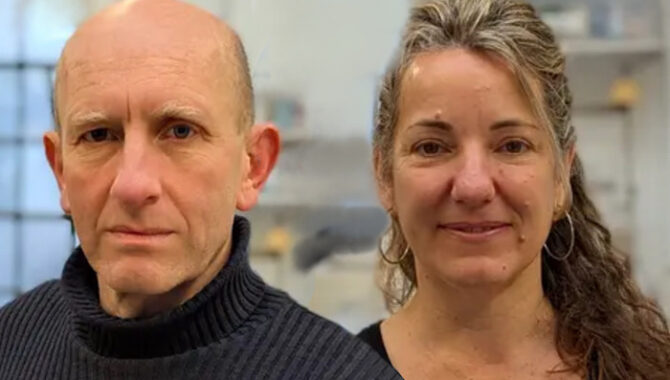
Discover what Plunge Creations does for brands including Rick and Morty, Wicked and The Masked Singer!
Sarah, Tim! Thanks for making time. Perhaps the best place to start is to introduce yourselves. Sarah?
Sarah: I’m Sarah Mead. I’m a Director at Plunge Creations. I started working there back in 2010… Around the time that Tim’s son was born, actually. The reason I know that is because, at that time, it was just Tim in the business and he needed an extra brain and pair of hands to run things.
And everything about my tour this morning says it wouldn’t run half so well without you!
Sarah: Ha! I don’t know about that!
Tim: I do! That’s absolutely fair! I’m Tim Simpson, Managing Director and Creative Director of Plunge Creations. The business was originally set up by my sister Zoe and her friends – Susie and Cath – as a theatre-production company. It all began when the three of them were sitting in a bar in Balsall Heath in Birmingham; all with low-cut tops on. They named the company after their plunging necklines. Ha!
Ha! I don’t know if you’re kidding or if this was in the 90s…
Tim: It WAS in the 90s! Ha! So in those early days, it was Plunge Productions in Birmingham. I worked with Bec’s Hurran to create the costumes in Plunge’s first production, which was Into the Woods up in Edinburgh. After that, I did other bits of set and costume design and so on. Over time, the other directors moved on and left me in control of the business. I then sculpted it sideways from production into the prop and costume maker that it is now. It was very much props to begin with, but Sarah and I have moved it more into costumes while growing it over the last 14 years.

Fantastic. I wish people could see the set up here to appreciate the joy of it, I really do. So you create props, costumes and installations… In terms of the licensed IPs you’ve done that for, on what kind of things have you worked?
Tim: It’s a whole range. Often, it’s companies that want to bring imaginary things to life. We might work with a company to make a giant figure of a computer-game character, say, or a cartoon. We worked with Cartoon Network to make a Rick and Morty spaceship that’s crashed to Earth, for example. It might be street art; it might be a giant Miffy that lights up and works like a bedside light. Anything that doesn’t exist in the real world and needs to…
So if I’m walking around Brand Licensing Europe and the stands have got a giant figurine…
Tim: We do a lot of characters for brands to use on their booths, yes. And those mascot costumes as well, of course! We now get a lot of enquiries about those off the back of The Masked Singer… People getting in touch because they need a crazy character costume. We design and make outlandish costumes that really are built to work. We recently did some work with Lipton’s Iced Tea, for example, and some things with DJs who want crazy helmets with tech inside them. It’s a really wide range.
Well, let’s talk about The Masked Singer… I can’t think of another TV show in which costumes more certainly define a brand. Is there more to designing these than meets the eye?
Tim: More than meets the eye, yes… When we’re designing, we have to think beyond something that just looks interesting. We’re designing characters that people can engage with immediately. That can be a huge challenge because masks are fundamentally scary. You stick them on to disguise yourself; they abstract you from your audience… They’re used in warfare. They’re used to fool people. They’re used to create mystery and distance between you and others…
When we create masks for The Masked Singer, though, or The Masked Dancer, we need to create instant familiarity and fun between the wearer and the audience. That’s quite a complicated thing to do because there’s always a risk of creating things that are fundamentally frightening… Have you seen any of those photos of kids sitting on the Easter Bunny’s knee, for example? Masked characters with kids that are just screaming?! That’s easily done with the wrong design. I’ll give you an example of one of our own challenges. A couple of years ago, Sarah proposed Knitting…
Which is a Masked Singer character?
Tim: Yes! Sorry! She didn’t just suggest knitting! Ha! Sarah proposed The Masked Singer character, Knitting. Essentially, the head is a ball of wool with two giant needles stuck in it. With the wrong design, it would be straight out of a horror show! But weirdly, if you make it fluffy enough and get the right colour scheme, it looks much more friendly. That’s incredibly important on the TV show because the audience has immediately got to root for these characters. They’ve got to see that the character’s fun, connect with it and say to themselves: ‘I like that! I’ll vote for them.’
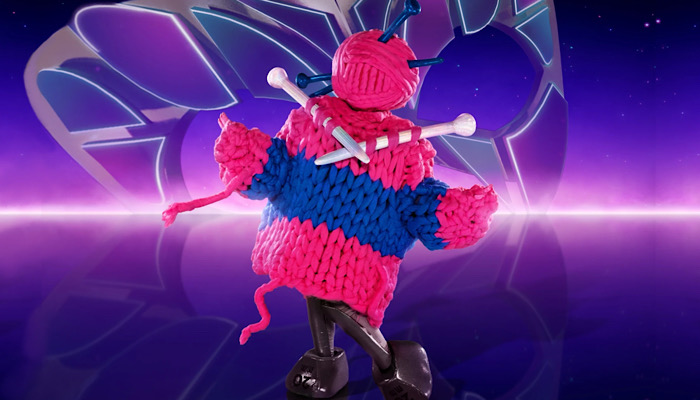
Sarah: This is one of the reasons we like it when the masks can have a face of sorts… Something recognisable: a smile, a sparkle to the eyes – something people can engage with. That often makes the design a little easier.
But I can’t imagine designing any of these characters is actually easy! Where do you start?
Tim: We just have stupid conversations on Zoom! Ha! That’s often how it starts. At the very beginning, the production company, Bandicoot, came to us with a list of things they wanted. Some of those I drew up – they looked promising. We came up with some other ideas ourselves. But today – after I’ve had a Zoom conversation with the producers – I share the design ideas with a couple of other team members. It’s more interesting that way because we get different people’s brains on it early.
After that, we sit around a computer and come up with more stupid ideas –some of which might grip one of us in particular, you know? “Oh, I want to do that one!”; “I want to try that one!” Then we then split up for a couple of weeks. When we regroup, we’ll have done a few sketches so that we can pitch them to the team. Some of them fly, some don’t! Generally speaking, we need 12 costumes for the show but we end up with about 18 to 20 fully designed options. As celebrities get on board, the producers then decide which two or three costumes might suit each singer.
And is there a suite of character types that you’re looking to provide?
Tim: Sort of, yes. We’ll be looking to offer a balance of inanimate objects, foods, animals – and some really weird things! Sometimes we might say, “We’ve got too many undersea creatures… Let’s do another insect.” Of course, the producers might then say, “No, we need a bird and we need something fluffy!” So yes, we collate a range from different inspirations. There are about seven or eight categories we need to cover. And some of the designs fly off the page; others take ages.
Are there some that surprise you, Tim? In terms of how hard they are to execute, I mean?
Tim: Oh, yes. Dragon comes to mind. The final design was really cute, but developing Dragon was torturous! I don’t really know why… We went through a lot of horrible dragons before we got to that final one. And, you know, sometimes I enjoy the process, sometimes I hate it – for the same reason I didn’t go to art college, I think, which is that I find blank-page syndrome emotionally disarming.
Oh, really? Well, that’s something I find fascinating – let’s come back to that! Presumably, though, you also have to choreograph a dance of sorts between the creative side of the design and the logic?
Tim: I think choreographing a dance is a great way to put it, yes. Logic really needs to inform the design of all our costumes because they need to do things. You’ve got to be able to see out of them, move in them, breathe easily in them, sing in them – dance in them in some cases… So we have to figure out a lot of practical things while making it look fun and interesting: where’s the eye line? How can you see out of this? How do we hide the eyes? How do we keep the people inside cool?
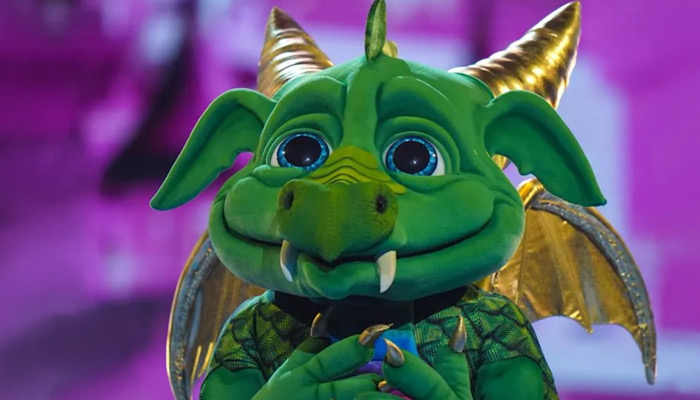
Crikey! You’ve mentioned a whole range of things there! Let’s talk about keeping people cool… Is that to do with the choice of fabrics?
Tim: Partly. But the underlying structure needs to be lightweight as well. We use a material called Varaform. It’s a light, heat-formable plastic mesh which comes on a roll. It’s a bit like the stuff they use instead of plaster for broken arms these days – just bigger. To get the shape right, what we do is clay sculpt our characters, then use the mesh to take a copy of the sculpt. That then forms the basic structure of the head. If you look at the beak of the Phoenix costume, for example, you can just see some of it there.
Oh, yes! There’s the mesh… That looks kind of cool; I assumed that was a style choice! But that’s the structure of Varaform?
Tim: Right. It lets air through so you can breathe more comfortably. When we build a costume, we always try to have a ventilation area about the size of an A5 piece of paper hidden somewhere. It might be holes in the ears, it might be vents on the top of the head so that you’ve actually got some airflow going! Either way, these masks are quite rigid, lightweight and breathable. But we can also build on second and third layers, bolt things onto it and – obviously – add all our fur and feathers!
So anyway, that’s a good way of handling the ventilation for The Masked Singer. If it was a costume character for a trade show or a cosplay, a common solution is to put little computer fans in there to get the circulation going. But we can’t do that on The Masked Singer because the TV microphones would pick them up. As a result, one thing you don’t see on TV is that – quite often – we’ll take the characters onto the stage and use little fans to blow cool air in through the mesh!
Ha! That makes absolute sense… It never would’ve occurred to me!
Sarah: I’m also just remembering that – back in series one – there was a character called Monster. That was a big costume… The celebrity literally had to wear ice packs in a holster round their body because it was so hot! There was just no other way of making him cool. The public would never know about that because they were looking where we needed them to look.

It’s like a magic trick! Gosh, I could talk about this all day, I really could! Something else that grabbed my attention though – and I see the top of it behind you, Sarah – is the Wicked Christmas Bookcase Tree at St. Pancras Station. This is a world away from costumes… When you do a branded installation like that, is it the same creative process?
Tim: Similar, perhaps. For that, Universal came to us alongside a company called Substance Global to talk about what the St. Pancras Christmas tree could be that year. That was the first restriction! It had to have the feel of a Christmas tree. They wanted to pitch a Wicked installation, but with a design which had the right spirit and wasn’t too heavily branded. It had to have a reason for being there other than just an advert because Historic England is involved in the site. There are parameters around how much branding you’re allowed, how much it looks like a product and so on.
Well, this is one of the reasons I thought it would be interesting to discuss. It’s got to be relevant to the brand without being crass!
Tim: The way we put it was that it wanted to be in the spirit of the movie, but it didn’t want to BE the movie. It can’t say Wicked all over it in huge letters, for example. But even in previous years, books felt like a great non-branded gift when Hatchard’s got involved. There, I designed the bookcase tree with booths at the bottom so people could sit down and listen to a story. The tree wasn’t fenced off so we figured out ways to create additional seating without it being an obstruction and people could sit and have a story read to them. People loved it.
Oh, it was fantastic! A little oasis of calm in an otherwise madly bustling thoroughfare. But very light on branding as you say…
Tim: It was really sweet, yes, and because it wasn’t so heavily branded, it didn’t feel too gauche… When Universal came to us wanting something with the same level of charm as that bookcase tree, we knew it needed to offer a sense of intimacy, calm and reflection… A space that you could go up to and engage, rather than see from behind a fence. So we worked with another company, MXW Studios, to develop the idea of an installation with windows, through which you could see a diorama inside…
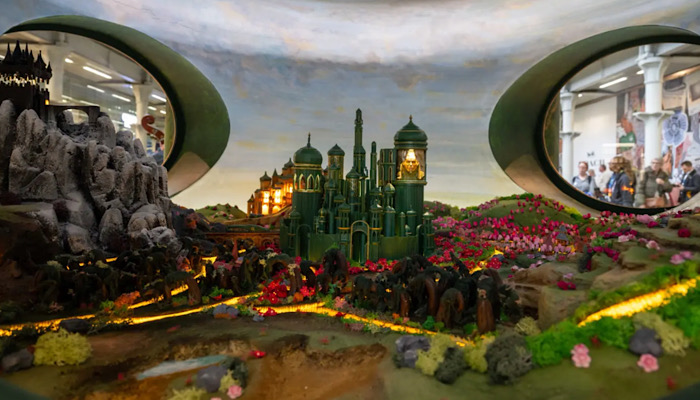
Which, I should explain for those that didn’t see it, was a scale replica of the land of Oz… The Emerald City, Shiz University and Munchkinland all linked up by an light-up yellow brick road!
Tim: So that was the heart of the branding, really; this beautiful, tiny, intricate thing that people could see through the windows. And because Wicked is a musical, it makes sense to have a bench where people can listen to some music. And then we had the Wizard’s head reproduced there as well! So there was a lot going on to fit their brand IP.
Oh, and it looked fantastic! It takes a lot to stop me in my tracks at that time of year, but I loved it. And how did it come together? What went into it?
Sarah: First, loads of love was put into it! Ha! We went though a LOT of movie stills looking for things we could recreate. And some of them are quite subtle…
Some of the textures on the wall panels, the paint finishes, the shapes.
Tim: Because the movie is this incredible mishmash of design. It’s got bits of Art Deco, bits of Art Nouveau, bits of Victorian ornament, bits of Moorish, bits of ancient Egypt… All mashed into the same thing. That makes it feel incredibly lavish. It’s a rich movie; really stunning and done with charm and love. Did you know they grew something like nine million real tulips for that film?
I did not! Nine million real tulips?
Sarah: Yes. Because they didn’t want to use CGI for everything. So the tulip field was real. In fact, the whole Munchkinland was a real set.! The centre of Emerald City was a real set, too. So yes, that love of craft that came from Universal fed into what they then commissioned from us. They wanted people to love it and really engage with it. We had a team come down from Universal to see us and they could see that everybody here really engaged with it.
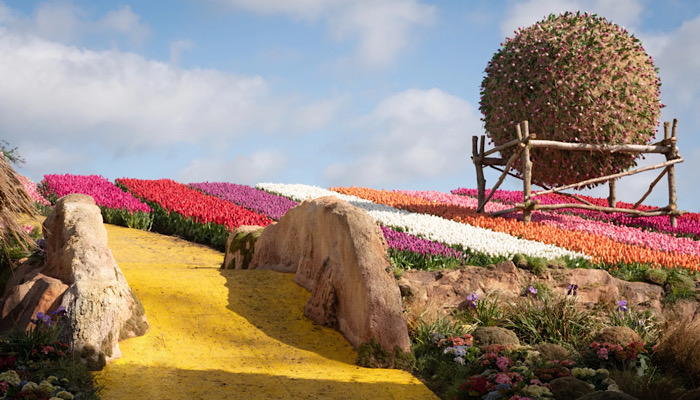
Tim: So we’d taken this design and understood what was important… The paint finishes were coming out great; the shapes and dioramas were coming out. It felt authentic and textural. I think that really appealed to them which meant we developed a nice relationship with Universal going forward because we took something that mattered a lot to them… And it clearly mattered a lot to us, too. In the end, it it mattered a lot to the public as well.
It did, didn’t it? You know, I love that we’re getting to talk about The Masked Singer and the Wicked tree because they’re totally different visuals, totally different material, totally different projects… But both existing on your spectrum of creativity, and allowing me to infer that you can do everything in between! Brilliantly, I might add.
Tim: Thanks, Deej.
Not at all. You mentioned earlier, Tim, that you find “blank-page syndrome emotionally disarming.” Am I to understand that you’ve sometimes felt stuck when starting from scratch? Or that you second-guess yourself?
Tim: Yes. On some projects, I just end up internalising it all and thinking nothing’s any good. You know that creative process where you turn against the brief, then you start work, then you turn against yourself?! Then you throw the whole lot away, maybe even stopping work for a few weeks…
Then, of course, the deadline gets closer! But in that time, you’ve been ruminating in the back of your head as to what you’re going to do, what it’s going to be – and you’ve actually been doing the work while you’re sleeping, or on your bicycle, or driving to work – whatever… Your mind’s been doing the work in the background. And then the pressure comes because the deadline arrives and you crack on and get it done.
When you’ve faced that inertia, Tim, have you found any technique or tool that kick starts you?
Tim: Deadlines, deadlines, deadlines! That kick up the ass you get from a deadline can sometimes really help. But also, sometimes just being able to accept that situation and take a moment to just pause… Take the pressure off… Just create some space. Get out the office, maybe go for a walk, go and watch something at the cinema… Anything that helps take my brain away from the moment and lets my mind carry on in the background.

Good answer. And is some of that extra pressure bought to bear because you’re flitting, Tim? Flitting between creative and logical responsibilities?
Tim: Very likely. So one of the reasons I now share the brief with two other members of the team is so that Sarah and I don’t kill one another because I just become really morose at times. I need to step away from it for a couple of weeks, have a silly idea, come back, draw something fun and then get over myself. Generally speaking, though, the ideas which come easily are the ones to go with because your brain is already on fire with them; you’ve already figured out some of the problems.
That said, Sarah is also excellent. She can walk around the workshop and call out something when it doesn’t look right… She knows when a finish isn’t quite right, or when a detail isn’t quite there. She’s another pair of eyes… And we both know what Plunge’s standards are and how to maintain them. We’ve also got an exceptional team that we know and work with – some of them we’ve worked with for years. We know how to shortcut through the weeds to sort things out.
Sarah: But for the last three or four weeks – just for example – Tim’s been designing software for the business… And yet he’s still got to somehow turn off that really logical part of the brain and go into playful mode for all the costumes, then switch back again – sometimes within a few minutes. So Tim’s day, as is true with most of us here, can’t be blocked out with one type of work. Tim doesn’t get to just sit and focus on design work in the same way that a project manager might. He might be managing four or five projects with different people running up to ask different questions. That’s just the nature of our business.
Yes, that sounds enormously challenging. And does being creative with other things help you push through that, Tim?
Tim: I do like discovering new techniques for this, that or the other, yes… So that might be new bits of software to learn, it might be a new piece of kit to figure out, it might be something new to work with. I might see a piece of material and feel inspired because of what that does. I’ll immediately find myself asking if it can help make sense of what I’m doing… And if it’s going to work within the budgets we’ve got? Because we do have to rein it in with some logic!
Sarah: Tim’s one of those rare creatives, Deej, that works across both sides. His brain works in both makey and mathic ways! His brain is a real mixture.
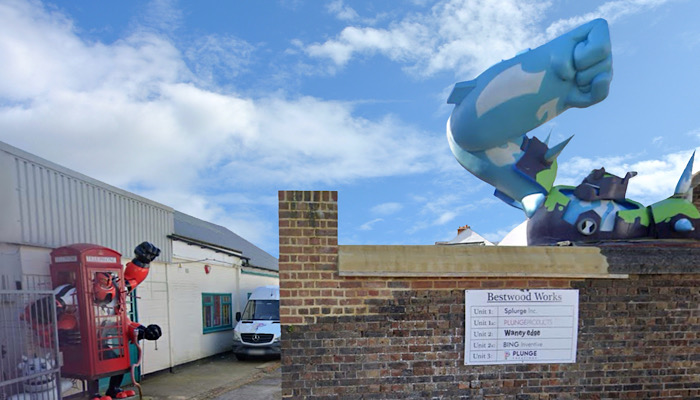
Makey and mathic! I like that; great phrase… Quite a rare brain, Tim?!
Tim: I was always part science and part art when I was at school and that still helps me here. I enjoy the engineering bits; I like problem solving, the technical end of the build as well as the creative end. But I often find my creative side constricted by the restraints of reality which can get in the way. I find that with a lot of my creative designers too; we often end up steering towards ideas that we know can be made relatively manageably… Whereas actually what you want is to go creatively bonkers and then figure out a way to do it later. But that can sometimes get you in a mess!
Someone recently used the phrase “commercial art” to describe these kinds of project… The artistic part of the endeavour can be as fanciful as you like, but there has to be a commercial execution of that art…
Sarah: Yes. That’s one thing a lot of clients are very good at. Clients tend to come to us with massive ideas that they’ve brainstormed – amazing concepts. When we look at them, our job is to ask ourselves how we translate that into something in the real world. And often, that starts by us asking: “What are you really trying to achieve?”
Yes… What’s the interest? What do they need to do?
Tim: And ultimately, the answer to that is very often “grab attention”; to turn people’s heads. That’s what we do… We turn people’s heads towards other people’s products. We make people feel excited by a TV show. We create the exciting bits! We don’t do the graunchy, hard-bloody-work stuff in the background! We do the shiny cherry on top. Ha!
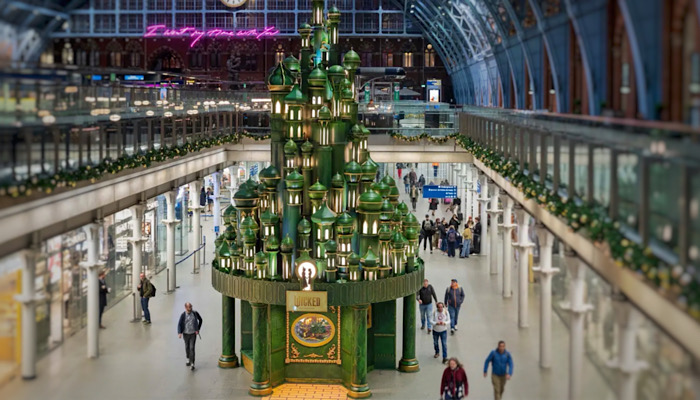
Ha! Kudos for using the word ‘graunch’; I don’t hear it enough! To wrap things up then, here’s my final question… Is there anything I could’ve asked you about today, but didn’t?
Tim: Not in terms of the creativity and things like that, no. But you know, we have a work experience program here and I also go and talk to local schools… I’ve taken masks to various schools to chat about making those. We’re having an open day in May to let people come in over the weekend as part of the Brighton Open Houses season. People can come and see the workshops…
Nevertheless, I think the creative industries in this country have taken a massive knock over recent years. I think they’ve been kicked in the teeth by being undervalued by various administrations. I see that reflected in the way my son is currently taking his options at school…
In his study options? How so?
Tim: In order to take two creative subjects, he has to drop a language because there are requirements to maths, English, all the sciences, the humanities and all this. But I look at it and wonder: aren’t there people, actually, who don’t need much of this at all? Now don’t get me wrong: I think English and math are perfectly useful… But do we all need to do history or geography? I don’t know.
Do we all need to do a language? I don’t know whether you do or not – but I do want to ask! Why can’t people take three languages and half a dozen creative subjects and say, ‘I’m going to go around the world being amazing!’?
Ha! I hear you! I’m not sure you should get me started!
Tim: Oh, really? Because I think there’s a real shame to it; that creative subjects are slowly drummed out of people. You know, we recently went and talked to teenagers in a school about what careers they might look into. They were all talking about medicine, law, accounts, finance; all this stuff… And we were thinking: are these the only options your school steers you towards? But when we did the open house for the first time last year, there were so many kids that came in who just hadn’t realised that being a maker was an option.
That this is a thing; that using your brain to create, to design, to problem solve is a career!
Tim: Exactly, exactly right! That the stuff you see in the shops actually gets made somewhere; that there are sculptors, designers, seamstresses, inventors, technicians, engineers… Just everything! So how many people who walked past our bookcase tree and never thought about how it got created? This huge sculpture pops up overnight in one of the country’s busiest railway stations – how many people gave a second thought as to where it came from?
This really resonates with me because – going back a hundred years – I had to take some pretty stoic subjects that I was CLEARLY never going to use at the expense of either art or drama. At the time, I thought – as a magician – drama would help, so I had to drop art. It vexes me to this day that I never developed art into a skill; it never got explored or encouraged or structured into anything. Whereas sociology? Ha! Like I use that! Ha! I’m not even sure what it is! Ah, dear… I said you shouldn’t get me started.
Tim: No, but you’re right. It’s nonsense, isn’t it, to not be able to do drama and art as a combination if you’re inclined to? They’re perfect bedfellows. And still the choices that kids are given are really bizarre. But also, don’t bore kids… Kids need to learn and you can learn lots of different things and if you keep kids interested and engaged, then they will learn well. And sometimes that’s because they’re mathematicians or they’re writers or they’re scientists, and sometimes it’s because they’re performers or they’re painters or whatever. And I think it’s a real shame to knock that out of people.
Agreed. Completely. And as I recall, my brother had to settle for studying art and maths… What was that going to help him do? Paint by numbers?
Ha!
Ha! Something fundamentally wrong there. And I rather imagine all this impacts your ability to recruit, does it?
Tim: Oh, absolutely. And despite Brighton’s inclusive reputation, it’s not the most ethnically diverse place in the world, so Plunge has found it especially hard to recruit people from ethnic minorities. Historically, ethnic minorities have always been underrepresented in the UK’s creative industries, and the knock-on effect from that is we still don’t see a great number of African American, Indian, Asian, South American or Hispanic creatives. We just don’t see that many people showing an interest, let alone applying for roles.
Gosh, that’s a huge surprise to me. How disappointing! Well, look, that feels like a somewhat regrettable note to finish on but it’s certainly food for thought…
Tim: Yes, it’s a whole other conversation…
It’s a whole other conversation, but it’s an important one and I’m glad you mentioned it. Thank you Tim, thank you Sarah. I hope you’ll come back and talk to us again.
Enter your details to receive Brands Untapped updates & news.